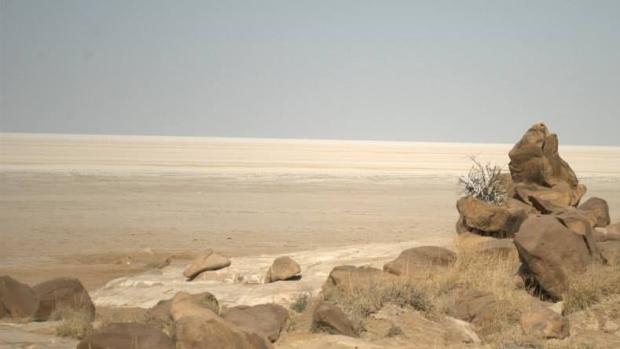
Photo : Purabi Deshpande / Research Matters
The monotonous expanse of the Great Rann of Kachchh in the Thar Desert is filled with seasonal salt marshes interspersed with vast mudflats that are dry during summer and are swamped during the summer monsoon and winter. Within this harsh, landlocked, shallow, marine basin lies buried a treasure trove of information about the Bronze Age Harappan civilization and the enigma of the Saraswati – a long lost river.
The curious case of the Saraswati has intrigued many philosophers, poets, scholars and now geologists. This mighty river is thought to have originated in the Himalayas, flown parallel to the Indus and emptied into the Arabian Sea somewhere near today’s Rann of Kachchh, about 2000 years ago. Interestingly, today, the river does not exist; nor there is any obvious evidence of its existence in the past. All that remains is a collection of hymns in the Rigveda praising this great river. While the Rann of Kachchh remains one of the least investigated areas due to its extreme climate, a new study is now about to open the ‘Pandora’s Box’ regarding the truth behind the mighty Saraswati that once flew in its glory.
In a new collaborative study, researchers from the Department of Geology, the Maharaja Sayajirao University of Baroda, Baroda, the Physical Research Laboratory, Ahmedabad, and the Woods Hole Oceanographic Institution, USA have attempted to provide some interesting evidence for the existence of the river Saraswati by examining the sediments from the Great Rann of Kachchh. Published in the journal Scientific Reports by Nature, the study was largely funded by the Department of Science and Technology, Government of India.
“Our endeavour was to delineate the source of large volume of sediments that filled the Great Rann of Kachchh (GRK) basin”, remarks Prof. D. M Maurya, from the Maharaja Sayajirao University of Baroda and the corresponding author of the study. The researchers employed a two-pronged strategy to study the GRK basin and reported their results in two separate studies. The first study focused on the clay mineral assemblage in the GRK basin and the second analysed the strontium-neodymium (Sr-Nd) isotope evidence.
Clay mineralogy is the study of all aspects of clay minerals, including their properties, composition, classification, crystal structure, and occurrence and distribution in nature. The researchers’ study on the clay mineral composition in the GRK basin showed the dominance of the typical Himalayan derived sediments consisting minerals like illite and chlorite along with kaolinite that appears to have been contributed from local southern Kachchh Mainland hills, and smectites from the local igneous bodies and/or via Nara, the river flowing from eastern Pakistan into the Rann of Kachchh.
In the second study, the researchers recovered sediment samples near Dhoro village in the central Kachchh basin and analysed the composition of Sr-Nd isotopes in them. Analysis of these two isotopes helps us in determining the time of formation of the sediments and their constituents since different types of rocks formed at different time-periods have different constituents of these elements and their isotope ratios. This is the most reliable method to trace the source of sediments.
“These isotopes have been used successfully in resolving issues of sediment sources in many sedimentary basins around the world”, says Prof. Maurya about this methodology.
In addition, the researchers also compared the isotope ratios of Dhoro sediments with those samples from local active rivers like Rupen and Luni near the GRK basin, to verify the contribution of locally derived sediments into the GRK basin. Here too, they found that the Dhoro sediments were rich in minerals like illite and chlorite, indicating that these sediments originated from the Himalayas and/or Karakoram (a mountain range spanning the borders of Pakistan, India and China) ten thousand years ago during Holocene.
“Both studies provide clear evidence of Himalayan source for the sediments”, adds Prof. Maurya.
Though the two studies are significant in providing scientific evidence that the GRK basin was the final resting place of the sediments brought by the Saraswati, much work needs to be done before we know the exact trail of the river. “Our results should encourage further studies to track the entire course of the Saraswati river from GRK, through the Thar Desert and up to the Himalayas using scientific tracers”, hopes Prof. Maurya.
So, are we closing the debate on the existence of Saraswati? Not yet, says Prof. Maurya. “The ultimate answer would depend on future research which should focus on precisely reconstructing the entire course of Saraswati from Himalaya to GRK. This can be achieved by detailed geological, geophysical and geochemical studies”, he signs off.






